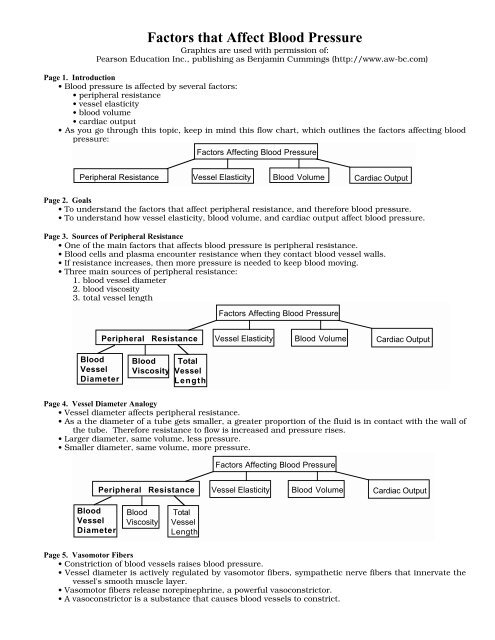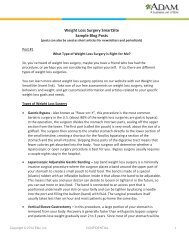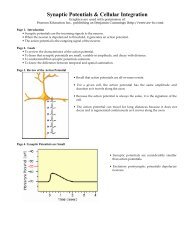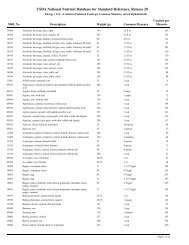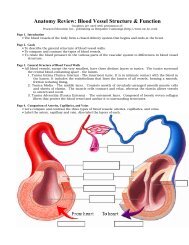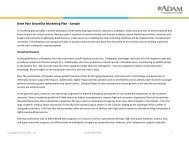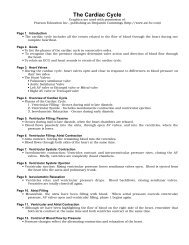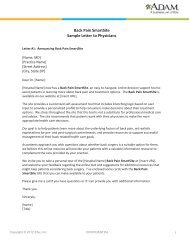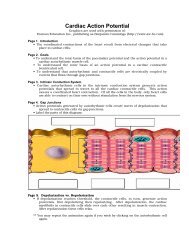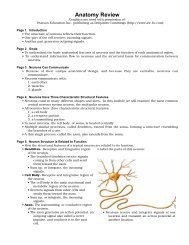Factors that Affect Blood Pressure - Pearson
Factors that Affect Blood Pressure - Pearson
Factors that Affect Blood Pressure - Pearson
You also want an ePaper? Increase the reach of your titles
YUMPU automatically turns print PDFs into web optimized ePapers that Google loves.
<strong>Factors</strong> <strong>that</strong> <strong>Affect</strong> <strong>Blood</strong> <strong>Pressure</strong>Graphics are used with permission of:<strong>Pearson</strong> Education Inc., publishing as Benjamin Cummings (http://www.aw-bc.com)Page 1. Introduction• <strong>Blood</strong> pressure is affected by several factors:• peripheral resistance• vessel elasticity• blood volume• cardiac output• As you go through this topic, keep in mind this flow chart, which outlines the factors affecting bloodpressure:<strong>Factors</strong> <strong>Affect</strong>ing <strong>Blood</strong> <strong>Pressure</strong>Peripheral ResistanceVessel Elasticity <strong>Blood</strong> Volume Cardiac OutputPage 2. Goals• To understand the factors <strong>that</strong> affect peripheral resistance, and therefore blood pressure.• To understand how vessel elasticity, blood volume, and cardiac output affect blood pressure.Page 3. Sources of Peripheral Resistance• One of the main factors <strong>that</strong> affects blood pressure is peripheral resistance.• <strong>Blood</strong> cells and plasma encounter resistance when they contact blood vessel walls.• If resistance increases, then more pressure is needed to keep blood moving.• Three main sources of peripheral resistance:1. blood vessel diameter2. blood viscosity3. total vessel length<strong>Factors</strong> <strong>Affect</strong>ing <strong>Blood</strong> <strong>Pressure</strong>Peripheral ResistanceVessel Elasticity <strong>Blood</strong> Volume Cardiac Output<strong>Blood</strong>VesselDiameter<strong>Blood</strong>ViscosityTotalVesselLengthPage 4. Vessel Diameter Analogy• Vessel diameter affects peripheral resistance.• As a the diameter of a tube gets smaller, a greater proportion of the fluid is in contact with the wall ofthe tube. Therefore resistance to flow is increased and pressure rises.• Larger diameter, same volume, less pressure.• Smaller diameter, same volume, more pressure.<strong>Factors</strong> <strong>Affect</strong>ing <strong>Blood</strong> <strong>Pressure</strong>Peripheral ResistanceVessel Elasticity <strong>Blood</strong> Volume Cardiac Output<strong>Blood</strong>VesselDiameter<strong>Blood</strong>ViscosityTotalVesselLengthPage 5. Vasomotor Fibers• Constriction of blood vessels raises blood pressure.• Vessel diameter is actively regulated by vasomotor fibers, sympathetic nerve fibers <strong>that</strong> innervate thevessel's smooth muscle layer.• Vasomotor fibers release norepinephrine, a powerful vasoconstrictor.• A vasoconstrictor is a substance <strong>that</strong> causes blood vessels to constrict.
<strong>Factors</strong> <strong>Affect</strong>ing <strong>Blood</strong> <strong>Pressure</strong>Peripheral ResistanceVessel Elasticity <strong>Blood</strong> Volume Cardiac Output<strong>Blood</strong>VesselDiameter<strong>Blood</strong>ViscosityTotalVesselLengthPage 11. <strong>Blood</strong> Volume Analogy: Hoses• <strong>Blood</strong> volume affects blood pressure.• When there is a greater volume of fluid, more fluid presses against the walls of the arteries resultingin a greater pressure.• When there is less volume there is less pressure.<strong>Factors</strong> <strong>Affect</strong>ing <strong>Blood</strong> <strong>Pressure</strong>Peripheral ResistanceVessel Elasticity <strong>Blood</strong> Volume Cardiac Output<strong>Blood</strong>VesselDiameter<strong>Blood</strong>ViscosityTotalVesselLengthPage 12. <strong>Blood</strong> Volume Examples• Reduced blood volume (for example due to excessive sweating) reduces blood pressure short term.Long term homeostatic mechanisms compensate, bringing blood volume and blood pressure backup to normal levels.• Increased blood volume (for example due to water retention from excessive salt intake) increasesblood pressure short term. Long term homeostatic mechanisms compensate, bringing bloodvolume and blood pressure back up to normal levels.Page 13. Cardiac Output: Heart Rate• Anything <strong>that</strong> decreases cardiac output, also decreases blood pressure, because there is lesspressure on the vessel walls.• An increase in cardiac output results in increased blood pressure.• Cardiac Output = Heart Rate X Stroke Volume• Anything <strong>that</strong> affects heart rate or stroke volume affects cardiac output and thus blood pressure.• What happens to heart rate, cardiac output, and blood pressure with parasympathetic stimulation(vagus nerve)?__________________________________________________________• What happens to heart rate, cardiac output, and blood pressure with sympathetic stimulation?__________________________________________________________<strong>Factors</strong> <strong>Affect</strong>ing <strong>Blood</strong> <strong>Pressure</strong>Peripheral ResistanceVessel Elasticity <strong>Blood</strong> Volume Cardiac Output<strong>Blood</strong>VesselDiameter<strong>Blood</strong>ViscosityTotalVesselLengthPage 14. Cardiac Output: Stroke Volume• <strong>Affect</strong> of stroke volume on blood pressure.
• If less blood is ejected from the heart with each beat, then blood pressure will be lower because therewill be less blood pressing against the vessel walls.• <strong>Blood</strong> volume affects end diastolic volume and therefore stroke volume.• With decreased stroke volume, due to decreased venous return, volume there is a decreased cardiacoutput and a decreased blood pressure.• With increased stroke volume, due to increased venous return and/or increased contractility, thereis an increased cardiac output and increased blood pressure.Page 15. Summary• Increases in peripheral resistance, blood volume, and cardiac output result in higher blood pressure.Conversely decreases in any of these factors lead to lower blood pressure.• Three main sources of peripheral resistance: <strong>Blood</strong> vessel diameter, blood viscosity, and total vessellength.• If arteries lose their elasticity and become more rigid, blood pressure increases.** Now is a good time to go to quiz question 1:• Click the Quiz button on the left side of the screen.• Work through quiz question 1.Notes on Quiz Questions:Quiz Question #1:• This question asks you to choose the factors <strong>that</strong> will decrease the blood pressure.Study Questions on <strong>Factors</strong> <strong>that</strong> <strong>Affect</strong> <strong>Blood</strong> <strong>Pressure</strong>:1. (Page 1.) What are the four main factors affecting blood pressure?2. (Page 3.) <strong>Blood</strong> cells and plasma encounter resistance when they contact blood vessel walls. What isthis resistance called?3. (Page 3.) Is more or less pressure needed to keep blood moving when resistance increases?4. (Page 3.) What are the three main sources of peripheral resistance?5. (Page 4.) What is the relationship between the diameter of a tube and the proportion of fluid <strong>that</strong> is incontact with the wall of the tube?6. (Page 4.) What is the relationship between the diameter of a tube and resistance to flow? What effectdoes this have on pressure?7. (Page 5.) Does constriction of blood vessels raise or lower blood pressure?8. (Page 5.) What actively regulates the diameter of blood vessels?9. (Page 5.) What chemical is released by vasomotor fibers <strong>that</strong> acts as a powerful vasoconstrictor?10. (Page 6.) List three blood-borne vasoconstrictors?11. (Page 7.) Explain viscosity.12. (Page 7.) What is the relationship between viscosity and pressure required to pump a fluid?13. (Page 8.) Define hematocrit.14. (Page 8.) What is the effect of hematocrit on blood viscosity?15. (Page 8.) When does hematocrit increase?16. (Page 9.) What is the relationship between the total vessel length, resistance, and blood pressure?17. (Page 10.) Why is expansion and recoil of the elastic arteries important?
18. (Page 10.) Why does blood pressure often increase in individuals with arteriosclerosis?19 (Page 11.) What is the relationship between blood volume and blood pressure?20. (Page 13.) What is the relationship between blood pressure and cardiac output?21. (Page 13.) What is the relationship between heart rate, stroke volume and cardiac output?22. (Page 13.) What happens to heart rate, cardiac output, and blood pressure with both parasympatheticand sympathetic stimulation?23. (Page 14.) What is the relationship between venous return and stroke volume?


